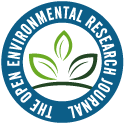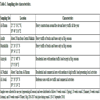- Home
- About Journals
-
Information for Authors/ReviewersEditorial Policies
Publication Fee
Publication Cycle - Process Flowchart
Online Manuscript Submission and Tracking System
Publishing Ethics and Rectitude
Authorship
Author Benefits
Reviewer Guidelines
Guest Editor Guidelines
Peer Review Workflow
Quick Track Option
Copyediting Services
Bentham Open Membership
Bentham Open Advisory Board
Archiving Policies
Fabricating and Stating False Information
Post Publication Discussions and Corrections
Editorial Management
Advertise With Us
Funding Agencies
Rate List
Kudos
General FAQs
Special Fee Waivers and Discounts
- Contact
- Help
- About Us
- Search
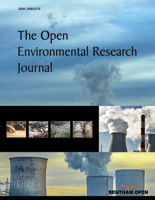
The Open Environmental Research Journal
Formerly: The Open Ecology Journal
ISSN: 2590-2776 ― Volume 16, 2023
- New Journal Website
- Journal Home
- Editorial Board
- Board Recruitment Workflow
- Instructions for Authors
- Plagiarism Prevention
- Fabricating and Stating False Information
- Research Misconduct
- Post Publication Discussions and Corrections
- Allegations from Whistleblowers
- Advertising Policy
- Short Guide
- Editorial Policies
- Publishing Ethics and Rectitude
- Quick Track Option
- Reviewer Guidelines
- Guidelines for Guest Editors
- Publication Fee
- Publication Cycle - Process Flowchart
- Archiving Policies
- Special Issues
Airborne Carcinogenic Trace Elements Distribution Associated with Long Term Exposure in Makkah Population
Heba M. Adly1, Saleh A. K. Saleh2, 3, *, Abdulla A. Saati1, Samir H. Fatani2
Abstract
Background:
More than 4 million international pilgrims visit Makkah each year during the Hajj and Umrah seasons. Since trace elements are natural ingredients that endure general biogeochemical cycling, conversion functions between environmental loadings, mass levels, and exposed receptors.
Objective:
This study aimed to evaluate the distribution of carcinogenic trace element levels related to long term exposure.
Methods:
Particulate Matter (PM10) sampling was conducted at six locations (Al-Haram, Arafat, Muzdalifah, Aziziyah, Al Nuzhah, and Al Awali). On-site measurement parameters included ambient temperature, wind speed, and direction over 37 weeks. Samples were investigated for Cd, Cr, As, Be, and Ni levels with inductive coupled plasma mass spectrometry. Quality assurance measures were achieved separately by analyzing a control sample to certify reliability, reproducibility, and linearity for each analysis.
Results:
Average particulate matter concentration for a one-year period presented significant variability, which exceeded the WHO guidelines for average exposure (25.0 µgm-3). PM10 average concentrations during round-1 (Spring), round-2 (Summer), round-3 (Autumn) and round-4 (Winter) were 120.1 ± 52.2 µgm-3, 223.4 ± 30.4 µgm-3, 77.6 ± 36.72, and 89 ± 62.7 µgm-3, respectively. The concentrations of Cd, Cr, As, Be, and Ni were found to be 0.098, 0.008, 0.26, 0.03, and 0.012 µgm-3, respectively.
Conclusion:
PM10 concentration was highly correlated (p-value <0.005) with Cd, Cr, As, Be, and Ni; thereby indicating the influence of manufacturing discharges and pollutants transported over long-distances. Higher ambient air temperatures may cause atmospheric instability in low air dispersion around Makkah. This highlights the importance of continuous air monitoring and calculation of dose exposure levels of both PM10 and trace elements.
Article Information
Identifiers and Pagination:
Year: 2019Volume: 12
First Page: 7
Last Page: 14
Publisher Id: TOECOLJ-12-7
DOI: 10.2174/1874213001912010007
Article History:
Received Date: 03/07/2019Revision Received Date: 22/08/2019
Acceptance Date: 29/08/2019
Electronic publication date: 30/09/2019
Collection year: 2019
open-access license: This is an open access article distributed under the terms of the Creative Commons Attribution 4.0 International Public License (CC-BY 4.0), a copy of which is available at: (https://creativecommons.org/licenses/by/4.0/legalcode). This license permits unrestricted use, distribution, and reproduction in any medium, provided the original author and source are credited.
* Address correspondence to this author at the Clinical Biochemistry & Tumor Biology, Faculty of Medicine, Umm Al-Qura University, P.O. Box: 715 Makkah 21955, Saudi Arabia; Tel: +966 555569260; E-mail: Saleh-A-S@hotmail.com
| Open Peer Review Details | |||
|---|---|---|---|
| Manuscript submitted on 03-07-2019 |
Original Manuscript | Airborne Carcinogenic Trace Elements Distribution Associated with Long Term Exposure in Makkah Population | |
1. INTRODUCTION
Airborne trace elements have been of concern due to their contribution to cancer worldwide, especially to lung cancer. No strong evidence between air pollution and cancer has been provided, even though some studies have shown about 1.3 million new cases of lung cancer per year, globally (WHO, 2017). Evaluations were completed on the load of cancer attributable to ecological aspects and air pollution effect to cancer. Estimations of correlation between cancer occurrence and air sources have been ended for definite air pollutants including trace elements. These evaluations have revealed that 3-5% lung cancer cases were associated with ambient air pollution. Cohen et al. (2004) calculated the number of deaths due to lung cancer to be 62,000 per year. Indoor air pollutants from fuel-burning were projected to cause 16,000 lung cancer deaths per year. Nevertheless, these estimates were not made for all regions and subregions (Smith, 2004). In Saudi Arabia, the total number of newly reported cancer cases was 24,485 in 2018, whereas the number of deaths due to cancer was 10,518. About 5.7% of the recorded cases of cancer were due to lung cancer, 6% due to thyroid cancer, and 7.2% were due to leukemia (WHO, 2019). Ambient air pollution in Saudi Arabia has become a serious topic of discussion due to interest in economic and social development related to over-consumption of fuel (USEPA, 2007). Moreover, there has been a significant increase in the quantity of stationary (industries) and mobile (trucks, cars, buses, etc.) air pollution sources.
As measures to regulate air pollutants are inadequate, poor urban air quality remains a problem in Saudi Arabia's major cities (Alharbi et al., 2015 and Nayebare et al., 2016). Saudi Arabia's macroclimate is naturally semi-arid to arid, thereby leading to persistent pollutants over time. Sandstorms play a considerable part in the contribution of smog in Saudi Arabia. Furthermore, some studies have revealed a substantial involvement of anthropogenic discharges typically linked to vehicles emissions. Makkah is exceptional in its characteristics. During Hajj and Omrah periods, it accepts about 4 million pilgrims from around the world, annually (Al-Jeelani, 2009). This leads to an increase in the usage of public transport (buses, trucks, cars) to convey pilgrims, and therefore an increase in the consumption of gasoline and concentrations of suspended dust. Thus, air pollution emission from cars is significant. Previous studies have stated that emissions from trucks and buses, wind-blown dust and gravel, fuel fading, and dissolved petrol and air conditioners are the key causes of Makkah air pollution (Habeebullah, 2013 and Simpson, 2014). The association between sources, exposure, and effect of metals to humans and to their environment are multifaceted, depending on the specific location, environmental state, and receptors. Since trace elements are naturally occurring and related to biogeochemical cycling, there are changeover functions among ecological loadings, mass media levels, and exposed humans (USEPA, 2007).
1.1. Airborne Trace Elements and Cancer
There are adequate studies to indicate that arsenic complexes lead to skin and lung cancers. Studies have also revealed that exposure to mineral compounds may raise the risk of lung cancer in industrial laborers working in pesticides industries or as metal miners. Most studies showed a positive association between exposure dose and cancer occurrence (WHO, 2006). Exposure to airborne arsenic raises not only the risk of lung cancer but also raises the risk of different types of cancer (Enterline et al., 1995). A Swedish study showed an upsurge in the risk of colon cancer amongst laborers in Swedish copper smelters (Wingren, 1993). Other studies showed cancer risks and its relation to occupational exposure to different metals in glass manufacturing industries in south-east Sweden, with results presenting a dose-related association between workers and stomach and colon cancer (Steven, 2006). Typically, higher mortality ratios for bladder, lung, liver, kidney, skin, and colon cancers were seen in residents where arsenic contamination of water supply was prevalent (The American Cancer Society Report, 2019). Lung cancer is a critical effect following contact with arsenic via inhalation (Agency for Toxic Substances and Diseases Registry, 2009). It has been reported that workers at smelters in Washington who were exposed to 50 µgm-3 of arsenic in the air for more than 25 years were at a relative risk of about 3. The lifetime risk of lung cancer was calculated to be 7.5x10-3 µgm-3. A recent study for 10 years of follow-up generated higher mortality rates due to lung cancer (Elwira, 2017).
Mortality rates among workers with less than 20 years of arsenic exposure after their first exposure to arsenic and among workers with more than 20 years of arsenic exposure were compared, and it signified relatively short expectancy ratio. The authors debate that this could be related to exposure via inhalation. However, subsequent high mortality rates associated with periods of inactivity (low cumulative exposure) that are not closely related to arsenic exposure but for some other exposures, may also be a reasonable explanation for cancer occurrence (WHO, 2018). In the USA, the National Toxicology Program Board of Scientific Counselors Reports on Carcinogens Subgroups endorsed to upgrade cadmium and cadmium compounds to “known to be human carcinogens” (National Toxicology Program, 2019). US EPA derived a unit risk estimation of 1.8x10-3 (µgm-3)-1. Moreover, the calculated SMR (Standard Mortality Ratio) in the US population was used as a reference. High lung cancer mortality was reported in the entire cohort (SMR = 149, 95% Confidence Interval (CI) 95-222). Lung cancer deaths were found to be high among workers from the highest cadmium exposure group (SMR = 272, CI 123-513), and among workers with 20 years or more of arsenic exposure, since their initial exposure (SMR = 161, CI 100-248) (Stayner et al., 1992). The Maximum Likelihood Estimate (MLE) of lung cancer risk at 200 µgm-3of 112.1/1000 (upper bound 177.9/1000) was derived by OSHA (Occupational Safety and Health Administration). The consistent risk at 100 µgm-3 was 58.3/1000. Using a Poisson Regression Model, the 95% upper confidence limit at 1 µgm-3 was found to be 1.0/1000. These estimates are consequential with occupational exposure circumstances. Risk with constant exposure situations was reasoned via a correction factor of 4.36 for 5 days a week, 45 of 70 years of life, and 10 versus 20 m3 breathing volume per day. This leads to a unit risk of 4.2 x 10-3 which is in r agreement with a unit risk of 4.4 x 10-3 based on the Poisson Regression Model. The MLE of the risk of continuous exposure at 1 µgm-3 was 2.45 x 10-3(USEPA, 2000). The reanalysis of this study by means of cumulative exposure estimates based on a more comprehensive job history established a relation between cadmium cumulative exposure and lung cancer (Sorahan, 1997). Nevertheless, a substantial drift for a risk of lung cancer was created only for cadmium exposure along with arsenic trioxide.
In the UK, a study conducted in a zinc-lead-cadmium smelter determined that lung cancer mortality is positively correlated to the duration of occupational employment and to cumulative exposure to arsenic and lead but not to cadmium (Ades, 1988). Moreover, some meta-analysis studies based on cadmium-exposed workers presented high cancer risk due to occupational cadmium exposure by inhalation and indicated an increase in carcinomas of the prostate (Chen et al., 2016). In chronic inhalation studies conducted by the U.S. National Toxicology Program, male and female rats were exposed for 6 h/day for five days per week for a total of 112 weeks. With respect to the inhalation carcinogenicity bioassays in mice, negative results were obtained for nickel sulfide and nickel sulfate. Consequently, the results in mice are not interpretable with respect to alterations in the carcinogenic potential of the compounds. This information confirmed that multiple forms of nickel increase the growth of lung cancer (National Toxicology Program, 2002). Respiratory cancer risk is mainly related to soluble nickel at concentrations greater than 1 mg Ni/m3 and to exposure to less soluble forms at concentrations greater than 10 mg Ni/m3. Currently, numerous cancer risk estimates for nickel compounds exist based on the newest evidence of exposure and the risk estimated in industrial populations is at a concentration of 1 µgm-3 of 3.8x10-4 can be given. The concentrations corresponding to an excess lifetime risk of 1:10,000, 1:100,000, or 1:1,000,000 are about 250, 25 or 2.5 ng/m3, respectively (WHO, 2002).
This study aimed to evaluate the distribution of carcinogenic trace element levels with respect to long term exposure around Makkah and to provide a detailed comparison of the trace element levels, globally. It may assist relevant authorities in developing regulations and strategies for developing air quality management to protect the pilgrims’ health.
2. MATERIALS AND METHDOS
2.1. Samples Collection
This study was conducted in the Makkah region of Saudi Arabia located at 21.35 [21° 21' 1 N] latitude and 39.97 [39° 58' 1 E] longitude. Makkah is surrounded by the Sarawat Mountains. Like most regions in Saudi Arabia, the weather in Makkah ranges from warm to hot throughout the year, with extreme heat during summer. The 24-h PM10 sampling was conducted at six sampling sites around Makkah (Al-Haram, Arafat, Muzdalifah, Aziziyah, Al Nuzhah, and Al Awali), which represented different sampling characteristics (Table 1). The study was done for a period of one year, that is from March 2016 to February 2017.
2.2. Meteorological Parameters
On-site measurements included parameters of ambient air temperature, wind speed, and direction. Ultraviolet (UV) radiation and rainfall rate were studied using Davis Instruments Vantage Pro Plus (Davis Instruments, USA). Meteorological data were measured at a height of 10 m, using a 47 mm Teflon filter at 16.6 l/min flow rate for 24-h per week, according to the USEPA standard method. Weather information and barometric pressure were also calculated. UV radiation was measured by the irradiance at UV wavelength, as the value significantly varies in ozone and cloud cover. Data (1-min averages) were collected and stored for one year and the daily averages were calculated. Data were collected in strict agreement with meteorological monitoring equipment standards (US Quality Assurance Handbook for Air Pollution Measurement Systems 2013).
2.3. PM10 Sampling
PM10 sampling was undertaken during all the seasons in the one year of study, including the Hajj pilgrimage, using a mini volume sampler (Airmetrics, USA) at 10 m height, using a 47 mm Teflon filter with 16.6 l/min flow rate for 24-h once per week for 37 weeks, according to the USEPA standard method (Method 29/2000). Each sampling filter with the collected particles was placed and stored flat on a clean Petri dish through weighing and storage. Filter weights were measured pre- and post-sampling using a microbalance (CITIZEN, USA). The filters were conditioned in a dry keeper before and after collection. Teflon filters for PM10 were weighed and conditioned at a temperature of 35-40 °C with a humidity of 60-70%.
2.4. Laboratory Analysis Methods
Collected filters removed 7 ml of nitric acid and 2 ml of ultra-pure water (ASTM type 1 water from Millipore filtration system, Millipore Cooperation, Massachusetts, USA) followed by microwave-assisted acid digestion using 5 ml of concentrated nitric acid, 3.0 ml of concentrated hydrofluoric acid, 2.0 ml of concentrated hydrochloric acid, and 1.0 ml of hydrogen peroxide in each sample pitcher. The sample containers were sealed and placed in a rotor (8×100) for microwaving. Samples
were analyzed for Cd, Cr, As, Be, and Ni concentrations in triplicate using inductive coupled plasma-mass spectrometry (Perkin Elmer7300, USA) according to the manufacturer’s manual. Trace elements were measured using the appropriate wavelengths according to USEPA Method 200.7, and two factors were considered: (1) the freedom from spectral interferences, and (2) the different sensitivities against the expected sample concentration. The observed interferences were compensated for by modifying the processing parameters, which was accomplished by adjusting the background correction points.
2.5. Quality Control Measures
Quality Assurance and Control (QA/QC) were achieved separately by analyzing a control sample with the samples repeatedly to ensure reliability; reproducibility, and linearity for each analysis. A linear calibration curve was constructed using a blank and five-point calibrators with concentrations of 0.01, 0.1, 0.2, 0.5, and 1.0 ppm for each element standards. All QC and collected samples were analyzed using 2% nitric acid. In all the 0.001-ppm QC checks, the determined concentration was within 20% of the true value, and the relative standard deviation was less than 6%.
2.6. Statistical Analysis
An average of 24-h of PM10 concentrations from different sampling locations was calculated as the 24-h average overall concentration for each season. This is defined in our study as a daily ambient PM10. The monthly mean concentration of trace elements was gathered for chronological evaluations to determine whether there was a statistical difference in the mean values according to seasons. One-way ANOVA (SPSS, 2017) was used to test the difference in trace element concentrations and seasonal variations, and the significance level was set at p<0.05.
3. RESULTS AND DISCUSSION
3.1. PM10 Levels and Seasons Variations
The average 24-h PM10 and meteorology parameters including temperature, Relative Humidity (RH), and Wind Speed (WS) during the study are revealed in Table 2. The average 24-h PM10 concentrations presented significant variability, which exceeded the WHO guidelines for the daily average exposure (25.0 µgm-3). Average concentrations of PM10 during round-1 (Spring), round-2 (Summer), round-3 (Autumn), and round-4 (Winter) were 120.1±52.2 µgm-3, 223.4±30.4 µgm-3,77.6±36.72 µgm-3, and 89±62.7 µgm-3 respectively. Moreover, Makkah’s climate is dry all year round, which could play a significant role in regulating air pollution levels in the studied area (Fig. 1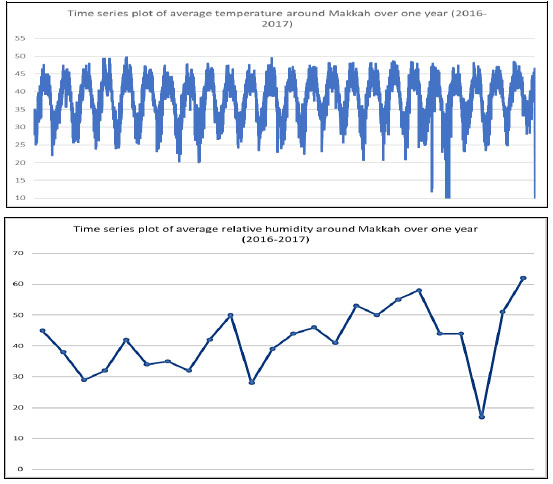 ). Therefore, high levels of PM10 throughout spring and summer seasons may be explained due to the reduction of air dispersion during that period as a result of the lesser atmospheric boundary layer. The observed data showed a high value of PM10 during the period of Hajj (August and September 2016), reaching a value of 270 µgm-3, another instance of high value was detected during the holy month of Ramadhan (May and June) at 138 µgm-3, representing heavy traffic load. Moreover, a comparison of PM10 concentrations by site and season showed steadily higher levels at Al-Haram sampling site, as compared to all the other sites; this could be easily related to high construction works in this area throughout the year. In 2015, another study conducted in Makkah found that the annual average PM10 level was 233.38 µgm-3(Habeebullah, 2016); however, a 2012 study in Jeddah (the city nearest to Makkah) displayed an annual average PM10 concentration of 87.3 µgm-3(Lee, 2010). This value was predictable as Jeddah and Makkah have different pollution sources and atmospheric conditions. This emphasized the foremost anthropogenic influence of traffic and construction works compared to the overall pollution levels in Makkah. Moreover, Fig. (2
). Therefore, high levels of PM10 throughout spring and summer seasons may be explained due to the reduction of air dispersion during that period as a result of the lesser atmospheric boundary layer. The observed data showed a high value of PM10 during the period of Hajj (August and September 2016), reaching a value of 270 µgm-3, another instance of high value was detected during the holy month of Ramadhan (May and June) at 138 µgm-3, representing heavy traffic load. Moreover, a comparison of PM10 concentrations by site and season showed steadily higher levels at Al-Haram sampling site, as compared to all the other sites; this could be easily related to high construction works in this area throughout the year. In 2015, another study conducted in Makkah found that the annual average PM10 level was 233.38 µgm-3(Habeebullah, 2016); however, a 2012 study in Jeddah (the city nearest to Makkah) displayed an annual average PM10 concentration of 87.3 µgm-3(Lee, 2010). This value was predictable as Jeddah and Makkah have different pollution sources and atmospheric conditions. This emphasized the foremost anthropogenic influence of traffic and construction works compared to the overall pollution levels in Makkah. Moreover, Fig. (2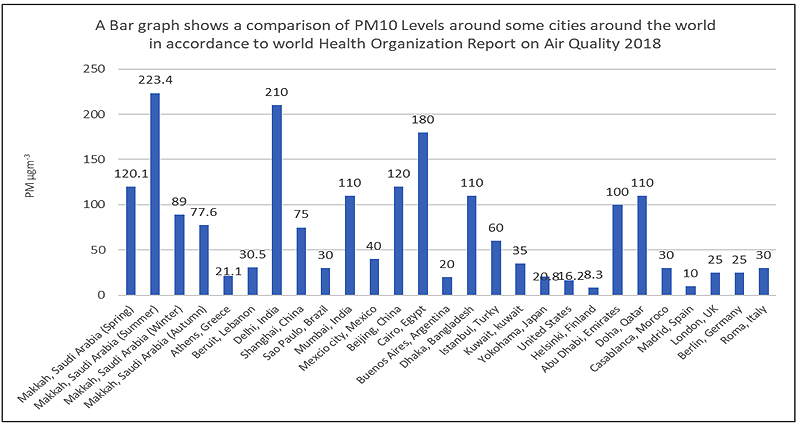 ) shows the exceedance of PM10 levels around Makkah with respect to WHO guidelines and compared these values to some other main cities around the world (WHO, 2016).
) shows the exceedance of PM10 levels around Makkah with respect to WHO guidelines and compared these values to some other main cities around the world (WHO, 2016).
3.2. Trace Elements and Seasons Variations
Cd, Cr, As, Be, and Ni were analyzed from the PM10 samples (Table 2). All measured trace elements levels showed high exposure levels. High-levels of Cr, Be and Ni can be attributed to the natural contribution from the soil to the measured PM10. The raised levels of Cd and As could be due to industrial and transportation emissions occurring locally along with long-distance transport from the neighboring cities of Jeddah and Rabigh. Concentrations of Cd, Cr, As, Be, and Ni were 0.098, 0.008, 0.26, 0.03, and 0.012 µgm-3, respectively, in summer, including the Hajj period and the fasting month of Ramadan, while the lowest values were detected in winter and were found to be 0.08, 0.009, 0.16, 0.002, and 0.01 µgm-3, respectively (Table 2 & Fig. 3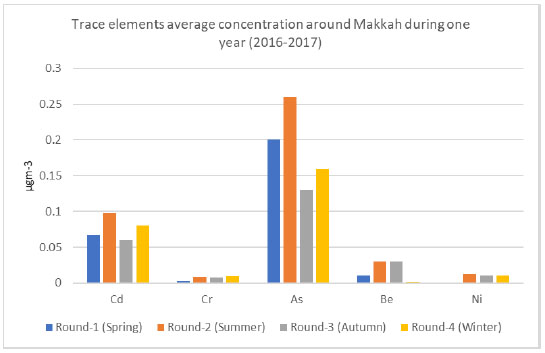 ). High values of trace elements concentration in summer are more likely owing to high temperature inversion, during which an increased number of PM10 particles are found closer to the earth surface due to increased atmospheric turbulence and blowing dust. Thus, metal contaminants were transported and dispersed in the studied area. The observed resulted aligned with another study conducted in Makkah, which reported that As, Hg, and Al had the highest concentrations in different samples of PM10, total suspended particles, and PM2.5 (Munir et al., 2016). The above results confirm the contribution of anthropogenic sources during Hajj and Umhra seasons to ambient air elemental concentrations, shown by the high levels of Cd, Cr, As, Be, and Ni, as compared to the average annual concentrations. Statistical analyses also showed the influence of different sources on PM10 levels and found that vehicle traffic and anthropogenic emissions related to high traffic as well as natural sources were the main pollutant sources. Regarding the influence of meteorological settings on PM10 and trace elements concentrations, it was found that hot weather conditions with low wind speed increased PM10 concentrations and the trace elements levels, signifying the effect of local sources on them.
). High values of trace elements concentration in summer are more likely owing to high temperature inversion, during which an increased number of PM10 particles are found closer to the earth surface due to increased atmospheric turbulence and blowing dust. Thus, metal contaminants were transported and dispersed in the studied area. The observed resulted aligned with another study conducted in Makkah, which reported that As, Hg, and Al had the highest concentrations in different samples of PM10, total suspended particles, and PM2.5 (Munir et al., 2016). The above results confirm the contribution of anthropogenic sources during Hajj and Umhra seasons to ambient air elemental concentrations, shown by the high levels of Cd, Cr, As, Be, and Ni, as compared to the average annual concentrations. Statistical analyses also showed the influence of different sources on PM10 levels and found that vehicle traffic and anthropogenic emissions related to high traffic as well as natural sources were the main pollutant sources. Regarding the influence of meteorological settings on PM10 and trace elements concentrations, it was found that hot weather conditions with low wind speed increased PM10 concentrations and the trace elements levels, signifying the effect of local sources on them.
3.3. Correlation between Pollutants and Makkah Meteorology
Correlations between PM10, trace elements constituents, and meteorological parameters are summarized in Table 1. PM10 was poorly correlated with temperature (p-value <0.0001) and relative humidity (RH; p-value 0.0002). The mean daily temperature showed a very minor seasonal variability (Table 2) with no significant daily variability over the study period. However, RH showed significant sequential variability. An increase in RH strengthened the hygroscopic growth of ambient PM, leading to an increase in PM concentrations. Trace elements concentrations were also correlated to high values and episodes of PM, indicating a significant involvement with the soil and earth crust. Most trace elements are primarily associated with transportation and
 |
Fig. (1) Time series plot of average temperature and wind speed around Makkah for one year (2016-2017). |
 |
Fig. (2) A bar graph showing a comparison of PM10 levels of cities over the world in accordance with the World Health Organization Report on Ambient Air Pollution and Diseases Burden, 2016. |
 |
Fig. (3) A bar graph showing average levels of trace elements around Makkah over a period of one year (2016-2017). |
industrial emissions from fossil-fuels/oil combustion (Nayebare, 2016 and Zhang et al., 2018). PM10 was highly correlated (p-value <0.0001) with Cd, Cr, As, Be, and Ni, indicating contributions from industrial emissions. Long-distance transport of levels. Higher ambient air temperatures can lead to unstable atmospheric conditions categorized by intense air currents and low air dispersion around Makkah. These issues highlight the need for continuous air quality monitoring and calculation of dose exposure levels with respect to both PM and trace elements (Heba et al., 2017).
Makkah is not an industrialized city. Yet, dust from industries within the region (oil refineries in Rabigh, desalination plants in Jeddah, steel processing, cement and chemical industries in Rabigh) significantly contributed to the high levels of PM measured in this study (Nayebare et al., 2018). Throughout the study period, there were infrastructural and construction developments in Makkah, involving the extension of the Holy Mosque. Future studies with more chemical species analysis with respect to PM10 could provide more explanation of the elevated levels of trace elements. All the measured trace elements in this study are considered carcinogenic, so further investigations are required to calculate dose-exposure levels. An accurate representation of population exposure to ambient air pollution is difficult, as there is limited knowledge regarding time-activity patterns and pollutant concentrations, especially in Makkah. Therefore, this study collected samples from different locations all year round. More studies should be conducted to compare yearly average concentrations in Makkah and to determine the annual average concentrations of trace elements; this would enable more accurate determination of cancer risk related to trace element exposure over a longer time period.
CONCLUSION
Particulate Matter (PM10) along with its chemical constituents, especially carcinogenic trace elements, such as Cd, Cr, As, Be, and Ni are considered a significant problem in Makkah. It was revealed that PM10 levels observed throughout the year represented various anthropogenic activities around Makkah including residential areas, mixed residential and commercial, hajj crowded areas and one background area. Furthermore, all the values exceeded the guideline values of PME (35 µgm-3) and WHO (25 µgm-3). This study assesses airborne trace element concentrations and their correlation with inhalation and carcinogenicity. Further research is needed to monitor additional trace elements and their carcinogenic effect related to long- and short-term exposure. Moreover, detailed studies are necessary to explore the ambient air trace elements and their effect on health due to long-term exposure.
AUTHORS’ CONTRIBUTIONS
All authors contributed equally to the article: (1) the conception and design of the study, acquisition of data, analysis and interpretation of data, (2) drafting the article, and (3) final approval of the submitted version.
ETHICS APPROVAL AND CONSENT TO PARTICIPATE
The study protocol was approved by the Ethics Review Board for Human Studies at the Faculty of Medicine, Umm Al Qura University.
HUMAN AND ANIMAL RIGHTS
No animals were used in this research. All human research procedures followed were in accordance with the ethical standards of the committee responsible for human experimentation (institutional and national), and with the Helsinki Declaration of 1975, as revised in 2013.
CONSENT FOR PUBLICATION
Informed consent was obtained from all patients and healthy subjects; the aim of the study and the required procedures were described to them beforehand. All the subjects were assured that they could choose to discontinue their participation in the study without jeopardizing the medical care being given to them, including treatment and follow-up.
FUNDING
This study was funded by King Abdulaziz City for Science and Technology (KACST) under the National Science, Technology and Innovation Plan (NSTIP), KSA.
CONFLICT OF INTEREST
The authors declare that they have no conflict of interest, financial or otherwise.
ACKNOWLEDGEMENTS
The authors would like to express their deepest gratitude to Mrs. Enas Ahmed Foud AlHady – Lecturer of Biochemistry at Umm Al Qura University for her significant contribution in sample collection and analysis.



